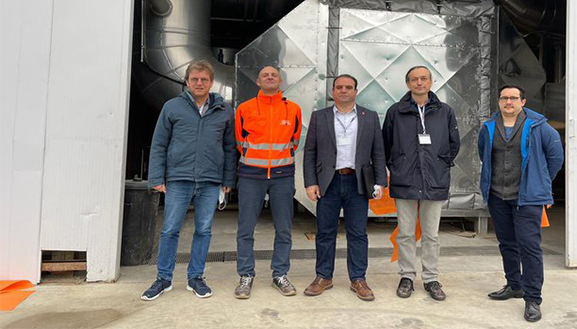Churning out the world’s toilets, tiles, plates and pipes, the resource-guzzling ceramics industry can go a long way to clean up its act, environmentally speaking.
Pumping out tonnes of pollutants like carbon dioxide and other gases while generating gallons of wastewater, ceramics is one of Europe’s less planet-friendly industries.
It hoovers up unthinkable amounts of natural gas to fuel burners that dry slip – a mix of water and clay – and heat its vast kilns up to 1250 °C.
Closeted away in the Northern Italian town of Pavullo, Atlas Concorde is one of Europe’s biggest ceramic tile producers. It is also the world’s first to reuse more than 40 per cent of its waste heat streams to heat high-pressure water used in the production process. It means huge-scale savings on energy, costs and emissions.
The mould-breaking heat pipe heat exchange technology making Atlas such vast energy savings is custom designed by Professor Hussam Jouhara and team at Brunel University London and made by Bridgend-based Econotherm (UK) Limited.
In 2019, the EU-funded DREAM (Design for Resource and Energy Efficiency in Ceramic Kilns) installed and started to monitor a 100 kW heat exchanger unit at a new-generation roller hearth kiln at Atlas’ Mirage tileworks.
Four years later, with a much bigger 0.7 MW heat pipe heat exchanger, this next-generation waste heat recovery technology has proved it can completely recast Europe’s ceramics industry for a cleaner, greener, more sustainable future.
"We installed a system which is the first of its kind in this industry," said heat pipe system designer Prof Jouhara, who heads Brunel’s Heat Pipe and Thermal Management Research Group.
"The system itself didn't impact the factory's day-to-day running. It is invisible to the process. All it does is save the company fuel and reduce its emissions. Its design draws on the experience that we have at Brunel and builds on the success of the research group in delivering macro-scale industrial projects working with international partners.
"We are recovering just above 2500 MJ of energy each working hour – enough to power the average UK home for over two months – and this is offsetting heat which would otherwise come from burning natural gas in a stage that dries raw materials."


Perched next to the cooling section exhaust stack, the heat pipe heat exchanger showed in six months that it has helped cut emissions by 205.5 tonnes a year and saved £28,000 a year in electricity bills. Without it, the waste heat and energy the factory generates in its production process would simply flush out into the environment, pumping out tonnes of pollutants with it.
“It lets the business make a direct saving on fuel consumption and a reduce its carbon footprint by burning less fossil fuel,” said Prof Jouhara. “This way, it cuts the factory’s overall carbon footprint, generates profit, giving the owner competitive advantage, which lets them increase their profit margins. It also puts them in a stronger position within the industry and allows them to generate higher level of growth within the market.
“Atlas are now considering replicating the system across all their sites.”
The exchanger installed at Atlas is one of three new types of heat exchanger designed, manufactured and installed by scientists and engineers working on EU-funded project, Etekina to recover waste heat that would otherwise literally go up the chimney. Others are a steel factory in Slovenia and an aluminium casting production plant in Spain.
Industry producers now need to become carbon neutral by 2050 and still have a lot to do, but with technology like heat exchangers on the horizon, that’s looking like a more realistic goal.